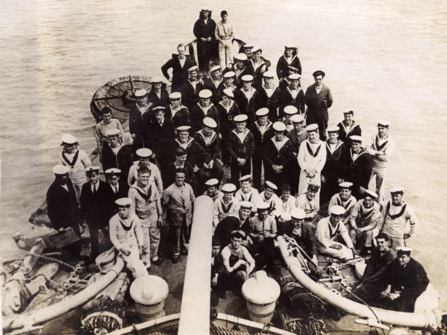Back

Collections
British Royal Navy & Royal Marines Service and Pension Records, 1704-1939
This collection comprises a wide range of British Royal Navy and Royal Marines records held by The National Archives. You’ll find service records, pension pay books, Greenwich Hospital application registers and more, searchable by name, date, service number and series.

- Date range
- 1704-1939
- Records
- 1,239,036
- Images
- 88,551
About this collection
The British Naval Service (of which the Royal Navy and Royal Marines are a part) is the oldest branch of the armed forces in the United Kingdom, dating back to the early 1500s. As such, it is also referred to as the Senior Service.
The modern Royal Navy was established after the creation of the Kingdom of Great Britain in 1707, when the Royal Scots Navy and the Royal Navy of England were merged. The Royal Marines – the infantry force of the Royal Navy – was founded in 1755.
From the late 1700s up through World War II, the Royal Navy was considered the most powerful navy then in existence.
The National Archives series included in this collection are as follows:
- ADM 6 / 223-320 – Registers of candidates for admission to Greenwich Hospital and registers of applications to Greenwich Hospital for admission, out-pensions or other relief, 1737-1859
- ADM 22 / 254-443 – Pay books of naval out-pensions at Greenwich Hospital, 1814-1846
- ADM 29 / 1-32, 34-131 – Admiralty: Royal Navy, Royal Marines, coastguard and related services: Officers’ and Ratings’ Service Records (Series II) 1802-1919
- ADM 73 / 1-69 and 95-131 – Admiralty: Royal Greenwich Hospital: Pensioners and School Admission Papers, Out Pensions Pay Books and Miscellaneous Registers 1704-1869, including general registers of pensioners and their families.
- ADM 363 - Royal Navy Seamen's Services Continuous Record cards, 1929-1950
- ADM 362 - Royal Navy Registers of Seaman's Services, 1925-1929
- WO 4 / 887-891 – Greenwich Hospital pensions 1846-1854
- WO 22 / 208 – Mercantile Marine: Miscellaneous returns for England, Scotland, Wales and Jersey
- WO 23 / 24 – Register of Greenwich Hospital pensions 1868-1870
- The National Archives, London, UK
Record series includes
Pensions
Some of the records in this collection relate to armed forces pensioners from the Royal Navy (seamen) and the Royal Marines (marines). Seamen and marines were awarded pensions at the end of their careers, after being discharged.
There are two types of pensions awarded by the Royal Navy and Royal Marines:
Out-pensions - Pensions awarded to veterans who were living independently
In-pensions - Pensions awarded to veterans living in the Royal Hospital Greenwich, which was the Navy’s care home for its veterans. Those living in the town of Greenwich referred to in-pensioners as 'Greenwich geese'.
Pensions were originally paid out of the Chatham Chest, which was a fund set up around 1590 for the sole purpose of paying pensions to disabled seamen. Contributions were deducted from members’ paychecks (sixpence per month) to finance the fund. However, in 1804, the Royal Hospital Greenwich took over responsibility for paying out pensions. Hence, ex-seamen and ex-marines receiving pensions were called Greenwich pensioners. Regarding the hospital’s funding, a visitor’s guide from 1855 explains that 'the Hospital is supported by its own property, with the exception of a grant from the Consolidated Fund in lieu of Merchant Seamen’s' Sixpenny Duty formerly paid to it. The income consists in the interest of funded capital; rents of estates in Northumberland and Durham; rent of property in Greenwich; a fourth of the commission on conveyance of freight in Her Majesty's ships; and receipts at the Painted Hall'.
Those applying for a pension are referred to as candidates. Once assessed, some were admitted to Royal Hospital Greenwich as in-patients. The in-pensioners were required to live by militarized regulations and standards, including the wearing of uniforms. Those admitted to Greenwich were free to discharge themselves, however, if they wanted to be re-admitted, there was a required one-year waiting period. Families of in-pensioners were not allowed to live at the hospital.
The 1855 visitor’s guide details the requirements for admittance of in-pensioners: 'The Pensioners must be Seamen or Royal Marines, who by their servitude at sea, in the Royal Navy, or wounds received, have established a claim to the benefits of the Institution. Merchant seamen who have been wounded in action with the ship of an enemy, or in a fight against a pirate or rebel, are also eligible for admission'.
The hospital could accommodate up to 2,710 in-pensioners. The visitor’s guide goes on to describe the facilities available to the in-pensioners: 'A Library containing about 1,500 well selected volumes is provided for their exclusive use, which is also supplied with daily and weekly newspapers. Their wards are spacious, well ventilated, and lighted with gas. Each man has a separate bed-cabin, or distinct bed-place, well furnished with horsehair mattresses, bedding, &c. […] In case of sickness, the men are immediately removed to the Infirmary, where every comfort and all that can contribute to their ease and recovery is liberally and kindly dispensed. […] A commodious piazza has lately been built on the western side of the building, on the new ground, for the use of those who smoke tobacco'.
Try the Social History Archive.